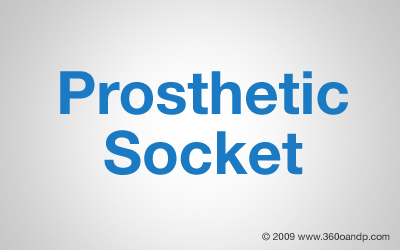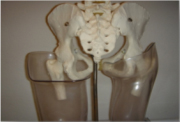

A prosthesis, or artificial limb, is composed of several components. The most crucial component of any prosthesis is the prosthetic socket. A socket is the portion of the prosthesis that the residual limb fits into. The role of the prosthetic socket is to hold the residual limb securely and comfortably while serving as the 'connection' to the other components of the prosthesis. Sockets are used in all upper and lower extremity prosthetic designs, with the exception of osseointegration prostheses, where the prosthetic components are connected directly to the amputee’s bone.
The most common prosthetic design prior to the 1950s was a ‘plug fit’, which typically incorporated a wooden socket lined with leather. The socket opening was carved, not specific for the limb, and was basically a simple cylinder shape. There was no attempt to compensate for volume changes of the residual limb. This fit is similar to a cork fitting into a bottle, with the residual limb not coming into contact with the bottom of the socket.
As technology advanced, medical professionals realized the best socket is a custom socket, unique for each individual. With this realization, the prosthetic industry came to develop many different socket designs and the concept of choice finally became a reality for the amputee.
Socket designs vary depending on the following:
A well fitting socket should:
-
-
-
Be designed in consideration of the amputee's ability to apply and remove the prosthesis.
"I had great components… a great knee, the best foot. But my prosthesis just didn't fit. It doesn't matter if you have the 'Cadillac' of components, right? If the socket doesn't fit, I can't wear it".
"If having a better socket fit means taking an extra few minutes in the morning to put on my leg, I'm all for it. I'd rather spend the time then and have a better fit throughout the day. It's worth it".
"My mom has a lot of problems using her hands now and she lives alone. She just doesn't have the strength for anything complicated or straining when she's putting on her prosthesis. She needs a simple socket that she can manage".